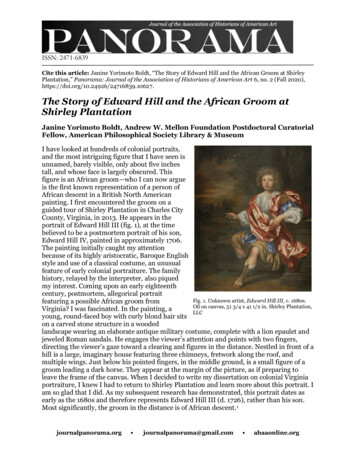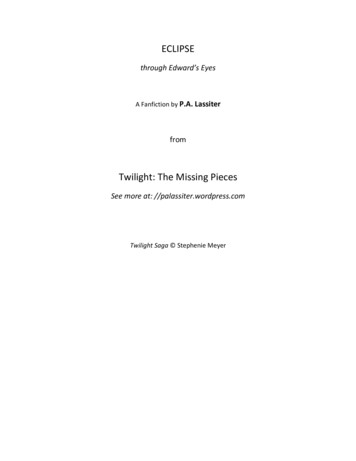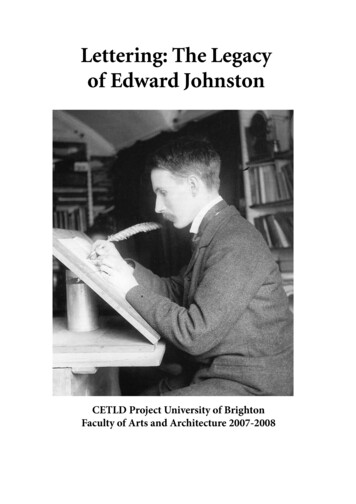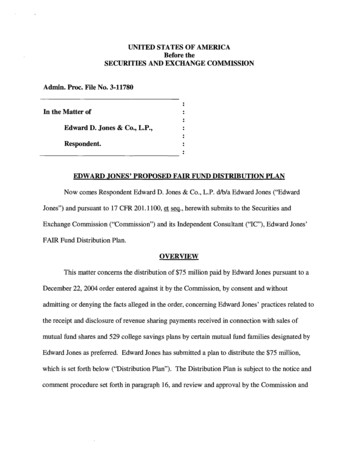
Transcription
ISSN: 2471-6839Cite this article: Janine Yorimoto Boldt, “The Story of Edward Hill and the African Groom at ShirleyPlantation,” Panorama: Journal of the Association of Historians of American Art 6, no. 2 (Fall 2020),https://doi.org/10.24926/24716839.10627.The Story of Edward Hill and the African Groom atShirley PlantationJanine Yorimoto Boldt, Andrew W. Mellon Foundation Postdoctoral CuratorialFellow, American Philosophical Society Library & MuseumI have looked at hundreds of colonial portraits,and the most intriguing figure that I have seen isunnamed, barely visible, only about five inchestall, and whose face is largely obscured. Thisfigure is an African groom—who I can now argueis the first known representation of a person ofAfrican descent in a British North Americanpainting. I first encountered the groom on aguided tour of Shirley Plantation in Charles CityCounty, Virginia, in 2013. He appears in theportrait of Edward Hill III (fig. 1), at the timebelieved to be a postmortem portrait of his son,Edward Hill IV, painted in approximately 1706.The painting initially caught my attentionbecause of its highly aristocratic, Baroque Englishstyle and use of a classical costume, an unusualfeature of early colonial portraiture. The familyhistory, relayed by the interpreter, also piquedmy interest. Coming upon an early eighteenthcentury, postmortem, allegorical portraitFig. 1. Unknown artist, Edward Hill III, c. 1680s.featuring a possible African groom fromOil on canvas, 51 3/4 x 41 1/2 in. Shirley Plantation,Virginia? I was fascinated. In the painting, aLLCyoung, round-faced boy with curly blond hair sitson a carved stone structure in a woodedlandscape wearing an elaborate antique military costume, complete with a lion epaulet andjeweled Roman sandals. He engages the viewer’s attention and points with two fingers,directing the viewer’s gaze toward a clearing and figures in the distance. Nestled in front of ahill is a large, imaginary house featuring three chimneys, fretwork along the roof, andmultiple wings. Just below his pointed fingers, in the middle ground, is a small figure of agroom leading a dark horse. They appear at the margin of the picture, as if preparing toleave the frame of the canvas. When I decided to write my dissertation on colonial Virginiaportraiture, I knew I had to return to Shirley Plantation and learn more about this portrait. Iam so glad that I did. As my subsequent research has demonstrated, this portrait dates asearly as the 1680s and therefore represents Edward Hill III (d. 1726), rather than his son.Most significantly, the groom in the distance is of African descent.1journalpanorama.org journalpanorama@gmail.com ahaaonline.org
Boldt, “The Story of Edward Hill and the African Groom”Page 2According to the family history, which is based heavily on oral tradition, as most of thefamily papers from the seventeenth and eighteenth centuries were destroyed or lost, theportrait features Edward Hill IV (life dates unknown). He was the only documented son ofEdward Hill III and his wife, Elizabeth Williams. Young Edward apparently died ofconsumption around 1706 at the age of sixteen, and as a result of his early death, ShirleyPlantation passed into the ownership of his sister, Elizabeth Hill (d. 1771), who marriedJohn Carter in 1723. Edward Hill III and Elizabeth Williams Hill supposedly commissioneda postmortem portrait of their lost male heir in the early eighteenth century. The Hill Carterdescendants believed that the English artist based the portrait on a preexisting miniature orengraving, but unfortunately, there is virtually no trace of Edward Hill IV in the archive, noris there an extant miniature or other likeness of the subject. Marion Carter Oliver, familyhistorian and longtime owner of Shirley, wrote down this oral history of the portrait in1937.2An 1846 Richmond Enquirer article conspicuously lists the portraits at Shirley as includingtwo portraits of Edward Hill, “one taken in early youth.”3 In the twentieth century, Olivertranscribed this list of portraits and wrote “Full of Mistakes!” on it.4 The article did make atleast one verifiable mistake: it identified Edward Hill III as the “founder of Shirley.” He wasactually the third of his name to live at the site. While the author of the 1846 article onlynamed the subject as “Edward Hill,” based on the context of the description and theexistence of a second portrait long identified as Edward Hill III as an adult, and whichstylistically dates to his adulthood in the early eighteenth century, the author wasidentifying Edward Hill III as the subject of both paintings. It seems likely that theidentification of his son as the subject of the painting of the child in Roman costumeoriginated in the mid- to late nineteenth century. By that time, the descendants were severalgenerations removed from the portrait commission, and such misidentification of acollateral ancestor was far more likely to happen.Absent seventeenth- and eighteenth-century Hill family papers, I turned to imperial andcolonial government records and to the papers of contemporary Virginia families in anattempt to learn more about the Hills. The family was wealthy and politically wellconnected, and they therefore appear in official colony records. What little about thebiographies of the three generations of Edward Hills in question—Edward Hill II (d. 1700),Edward Hill III (d. 1726), and Edward Hill IV (life dates unknown) that can be piecedtogether—also supports the identification of the boy in the portrait as Edward Hill III. Hisdate of birth is unknown; however, records related to Bacon’s Rebellion document that in1676 his mother was “bigg with child” and already had other young children, who wereimprisoned along with their mother by Nathaniel Bacon’s rebel forces.5 While the fate of hissiblings is unknown, it is likely that Edward Hill III was one of these children born in the1670s, making him the right age in the 1680s to be painted as a youth. The subject of thepainting has round cheeks and short curly hair, rather than an adult male wig, indicatingthat he was probably no older than sixteen. He also wears a costume over an unbuttonedwhite shirt. Allegorical costume was a popular late seventeenth-century English conventionfor children’s portraiture, as it evoked timelessness and supported dynastic familyambitions. Adult men also appeared in costume, although the state of undress tended to bereserved for women and children.6 Finally, the correspondence of the planter and traderWilliam Byrd I records that Edward Hill II traveled to England in 1685, which provided atleast one documented opportunity to have his son’s portrait painted.7Panorama Association of Historians of American Art Vol. 6, No. 2 Fall 2020
Boldt, “The Story of Edward Hill and the African Groom”Page 3Stylistic elements of the Hill portrait also belie its traditional dating to the early eighteenthcentury. The fabrics and the boy’s hairstyle date the portrait closer to the 1680s. By 1700,the elaborate gold and silver brocade fabrics, patterned textiles, and metallic fringe seen inHill’s garment gave way to solid, plain silks and simpler costumes in portraiture. Indeed, theHill portrait looks similar to works by prominent artists painting in London in the 1680s,such as John Michael Wright (1617–1694) and Willem Wissing (1656–1687). For example,Wissing’s portrait of Edward Rich, Earl of Warwick (fig. 2) shows a young boy with curlyhair dressed in an allegorical costume based on Roman military dress and seated in a forestlandscape. Warwick adopts a pose very similar to that of Hill. Both boys sit turned threequarters away from the viewer with one leg tucked behind the other, the front foot pointedtoward the landscape. Their position directs the viewer’s attention to the scene beyond, withone hand gesturing explicitly with pointed fingers to a house in a distant clearing. TheWarwick portrait features a country house similar to that appearing in the Hill portrait.While the artist of Edward Hill III is currently unknown, they were painting in afashionable Baroque English style, probably inspired by portraits such as Wissing’s Earl ofWarwick.Figs. 2, 3. Left: John Smith (engraver), Edward Cooper (publisher), after Willem Wissing, EdwardRich, 6th Earl of Warwick and 3rd Earl of Holland, 1684. Mezzotint, plate size 9 1/2 x 7 in.National Portrait Gallery, London, NPG D11907. Right: Circle of John Riley and John Closterman,William Byrd II in Roman Dress, c. 1680. Oil on canvas, 48 1/4 x 40 1/2 in. Virginia Museum ofFine Arts, Gift of Mrs. Edmund Randolph Cocke in memory of George Byrd Harrison, M.D., 56.30.Photograph by Katherine WetzelMost striking is the existence of another Virginia portrait featuring William Byrd II (1674–1744) (fig. 3).8 Dating to about 1680, when the subject was sent to England for school, thisportrait of Hill III’s contemporary also features a young boy wearing an antique Romanmilitary costume. The Hill and Byrd families were well acquainted and occasional businesspartners. Like young William Byrd II, Edward Hill III may have been painted when he wassent to school in England. Although Hill’s school records are unlocated, many wealthyVirginians sent their children abroad for education. Together, these two portraits supportPanorama Association of Historians of American Art Vol. 6, No. 2 Fall 2020
Boldt, “The Story of Edward Hill and the African Groom”Page 4similar dates of creation and suggest a possible tasteamong late seventeenth-century elite planters tocommission allegorical portraits.In the Hill portrait, the origin of the groom in thedistance, who appears to be African, was an intriguingand important mystery, for the painting has beendamaged and repaired over the years and wasconserved in 2012 (fig. 4). As would be expected froma portrait hanging in a Southern home for more thanthree hundred years, the painting exhibited multiplelayers of varnish, areas of overpaint, evidence of smallholes and scratches, paint loss in certain areas, andsubstantial crackling over the canvas. Remarkably,although the areas of the horse’s muzzle and aroundthe hooves were damaged, the figure of the groomremained in relatively decent condition.9 While it ispossible that the figure’s paint has darkened over theyears due to varnish and dirt, perhaps the most tellingvisual evidence for identifying the groom as an Africanfigure is his hairline, which is tightly cropped.European men, including grooms and otherFig 4. Unknown artist, Edward Hill III, c.attendants, typically have longer hair in seventeenth1680s (detail of groom and horse from fig.1).century paintings, while African figures, when notShirley Plantation, LLCwearing turbans, are almost universally painted withshort, tightly curled hair. In seventeenth-centuryEngland, African attendants were most frequentlypictured in portraits of women and children, althoughgrooms were occasionally represented in militaryportraits, as in Sir Godfrey Kneller’s Frederick Hermande Schomberg, 1st Duke of Schomberg (fig. 5). Thedepiction of an African groom in the Hill portrait wastherefore not without precedent.Additional circumstantial evidence that the groom inthe Hill portrait is African is found in the strikingresemblance of the horse and groom to figures of aTurkish horse with an African groom in a series ofpaintings copied from prints by Abraham vanDiepenbeck (fig. 6). The original printed images wereillustrations for a book by William Cavendish, Duke ofNewcastle, La Methode et invention nouvelle dedresser les chevaux, printed in Antwerp in 1658.Diepenbeck created a series of six horse and groomimages, among other illustrations, to accompanyCavendish's text on horsemanship. At least two Britishpaintings, one at Welbeck Abbey, the English estate ofCavendish, and one currently at Wimpole House (butnot original to it), show the Duke of Newcastle’sFig. 5. John Smith after Sir Godfrey Kneller,Frederick Herman de Schomberg, 1st Dukeof Schomberg, c. 1689. Mezzotint, plate: 15 x10 1/4 in. National Portrait Gallery, London,NPG D1338Panorama Association of Historians of American Art Vol. 6, No. 2 Fall 2020
Boldt, “The Story of Edward Hill and the African Groom”Page 5prestigious manège horses. Both of these paintings, dating to about 1665 to 1675, featuregrooms and horses from the Diepenbeck book illustrations.10 The Turkish horse with theAfrican groom appears in the far left of both paintings, practically walking off the canvas,just as in the Hill portrait. Moreover, the Hill groom wears a costume of a tunic and beltidentical to those in the British paintings, and it even appears to be rendered in the samegolden color as the African groom leading the Turkish horse. Additionally, the position ofthis groom in both the Diepenbeck images, a step in front of the horse and toward thebottom of the picture, is the same as in the Hill portrait, as are the poses of the groom’s feetand tilt of his head toward the horse so that he appears almost in profile. The gait of thehorse and the position of the reins in the paintings are also the same in all of theseexamples. The only apparent difference between the Diepenbeck images and the Hillportrait is the color of the groom's belt and leggings, but the darkened colors in the Hillportrait could also be the result of dirt accumulation and discoloration over the years. Sincethe Hill painting was completed in England, it is likely that the portraitist drew inspirationfrom these or related paintings and prints of the African groom with the Turkish horse.Fig. 6. Probably A. Sijmons after Abraham van Diepenbeck, Six of theDuke of Newcastle’s Manège Horses, c. 1670. Oil on canvas, 44 x 49 in.Wimpole Hall, Cambridgeshire. National TrustThe African groom would not be a recognizable individual to the audiences at ShirleyPlantation, and therefore it contributed to the objectification of the African figure. It ispossible that Edward Hill II and the artist chose to include a stock image of an Africaninstead of representing an individual enslaved by the Hill family simply because Hill and hisson did not travel to England with an enslaved attendant and therefore had to rely on animage of a groom that already existed in visual culture. It also may have been a purposefuldecision to render the African groom as a depersonalized symbol of wealth and status ratherthan as an individual. Regardless, by placing a stock groom without distinguishing featuresPanorama Association of Historians of American Art Vol. 6, No. 2 Fall 2020
Boldt, “The Story of Edward Hill and the African Groom”Page 6in the distance, the portrait visualizes a clear social hierarchy between the white subject andthe African attendant.The African groom’s unusual placement in the distance of the Hill painting is a subtle butimportant departure from English precedent. If the Hills were simply following Englishportrait practices, the African figure would be in a more prominent position within thecomposition of Edward Hill III. Typically, English portraits that include an enslavedattendant place the Black figure directly next to the white figure in the composition in orderto show them off. The Black figure usually looks at the white subject, directing the viewer’sgaze to the primary sitter and highlighting the attendant’s subservient position within theportrait and society at large, as in the Duke of Schomberg. The two figures interact in somemanner that reinforces the attendant’s servitude. The prominent presence of an enslavedfigure also underscores the wealth and access to luxury goods of the white subject.Meanwhile, the juxtaposition of their skin colors enhances the whiteness of the primarysubject, emphasizing their differences and presenting them as opposites.11 An Africanfigure’s ability to display the white subject’s wealth and whiteness is most effective whenplaced in a conspicuous position. The distant placement of the African groom in EdwardHill III was therefore an intriguing choice.The departure from English practice suggests that elite colonists were uncomfortable withthe realities of plantation slavery by the 1680s. The groom’s placement in the landscapenear the house is a visual association with property that is a reminder of the developingsocial order in Virginia. The choice of a groom, a personal attendant that did both domesticand agrarian labor, acting as a manservant while caring for horses, associates the Blackbody with land, animals, and both household and agricultural labor. Enslaved Africans weregenerally forced to labor in agricultural rather than domestic settings in order to maximizetobacco profits. Only the wealthiest planters could afford specialized, domestic enslavedlabor. This reality may have contributed to the groom’s distance; that he was a specializedattendant would have signaled the Hill family’s wealth and elite status in Virginia.More importantly, the groom’s distance disavowed the intimacy that existed on Virginiaplantations where enslaved Africans lived and labored in close proximity to the planterfamilies. Unlike in English portraits, this colonial painting does not allow the Black figure tocome too close to the white subject. William Byrd I expressed the Virginia elite’s discomfortwith the realities of plantation life in 1684/5. Sending his daughter, Ursula “Nutty” Byrd, tolive in England, Byrd wrote to his father-in-law, “My wife hath all this year urged me to sendlittle Nutty home to you, to which I have at last condescended . . . I must confesse shee couldlearne nothing good here, in a great family of Negro’s.”12 Byrd’s letter reveals the anxietyover cultural degeneration experienced by Anglo-Virginians who found themselvessurrounded by increasing numbers of nonwhite people. While the Hill family’s wealth is stillemphasized in Edward Hill III by the boy’s costume, the house, and the groom, the groom’sappearance in the portrait is minimized; yet, Hill points directly at the figure and the horse,ensuring that the viewer sees them in the distance. The portrait, like slavery itself, is full ofcontradictions.The appearance of the African groom in Edward Hill III during the 1680s is incrediblyimportant. As historians have argued, late seventeenth-century Virginia saw the rapidgrowth of the African slave trade and, in the decades that followed, the racialization ofslavery. Wealthy individuals in Virginia controlled the importation and sale of enslavedpeople during this period. Edward Hill II was involved in the African slave trade in thePanorama Association of Historians of American Art Vol. 6, No. 2 Fall 2020
Boldt, “The Story of Edward Hill and the African Groom”Page 71680s and 1690s as part of a consortium of elite planters using their mercantile connectionsand ships to import enslaved people from Africa and the Caribbean directly to their personallandings on the James River. The Hills also received black headrights for land; that is,patented land grants based on the number of enslaved Africans imported.13 The inclusion ofthe African groom in the portrait of Hill II’s son speaks to his and his peers’ investment inAfrican slavery as they increasingly purchased enslaved Africans, financed the trade, andturned away from indentured English servants.The well-known Justus Engelhardt Kühn portrait of Henry Darnall III of Maryland (c. 1710;Maryland Historical Society) was previously believed to be the earliest known African figurein a portrait produced for the British North American colonies. Edward Hill III, which waspainted in England, predates Henry Darnall III by up to thirty years. The paucity of colonialpaintings that include images of enslaved people makes each example important evidenceand adds to our understanding not only of the iconography of colonial slavery but of slaveryitself. As colonists grappled with how to represent slavery when confronted with its realities,their conscious pictorial choices provide insight into how they were actively constructingracial relationships and slavery.As scholarship on the relationship between slavery, art, and material culture continues togrow, the portrait of Edward Hill III is a reminder that there is still much work to be doneand new discoveries to make. Early Virginian art has long been neglected in art-historicalscholarship.14 The focus on Northern colonies and the occasional interest in Charleston andMaryland has overshadowed Virginia in the historiography. Virginia’s political importancein the colonial period and its centrality to understanding the development of slavery inBritish North America should be further examined in relation to its artistic productions. Thestory of the Hill portrait also prompts historians of American art to investigate thetransatlantic and British imperial nature of art in early America. After all, the-still unfoldingstory of the Hill portrait includes two transatlantic journeys and people on both sides of theAtlantic. Edward Hill II and Edward Hill III, the Virginia-born planter and his son, traveledto England, commissioned the expensive portrait from an artist’s studio, probably inLondon, and requested the inclusion of an African groom. Then Hill brought the portraitback to Shirley Plantation, his Virginia home, where he enslaved, imported, and sold Africanpeople and where enslaved laborers harvested tobacco that produced the family’s wealth.The portrait continues to hang there today, more than three hundred years later. Although itis an English portrait, it was also colonial, as it was commissioned by a colonist andintended for colonial audiences—audiences that included both settler colonial families andenslaved people.Notes1I sincerely thank the Hill Carter family and the staff of Shirley Plantation for sharing their family historywith me, granting me access to their portrait collection, and assisting with and supporting my research.The house is partially open to the public but remains in possession of the Hill Carter family, memberswho have lived on-site since 1638. For more on the Shirley Plantation, seehttp://www.shirleyplantation.com.2Notes about the Shirley Portraits in the Shirley Plantation Notebook of Robert R. Carter made by MarionCarter Oliver in 1937, and the Marion Carter Notebook, July 1942, Shirley Plantation Collection,University of Virginia Albert and Shirley Small Special Collections Library. The remaining Hill CarterFamily papers mostly date to the nineteenth and twentieth centuries. It is unclear exactly why Oliverchose to write the history down in 1937, though she was particularly interested in genealogy andPanorama Association of Historians of American Art Vol. 6, No. 2 Fall 2020
Boldt, “The Story of Edward Hill and the African Groom”Page 8corresponded with a number of relatives regarding familial histories. The Shirley Plantation Collectionwas acquired by the University of Virginia in 2018. I viewed the collection when it was held instewardship by the Colonial Williamsburg Foundation Rockefeller Library in 2016.3“Portraits at Shirley,” Richmond Enquirer 42, no. 98 (April 10, 1846): 1.4Marion Carter Oliver, “COPIED FROM RICHMOND ENQUIRER, Richmond, VA., April 10, 1846,”Shirley Plantation Collection.5“Defense of Col. Edward Hill,” Virginia Magazine of History and Biography 3, no. 3 (1896): 250; seealso “Charles City Grievances 1676,” Virginia Magazine of History and Biography 3, no. 2 (1895): 158.The identity of Edward Hill II’s wife in 1676 is uncertain. It is possible that her name was Elizabeth andshe was the daughter of the Elizabeth Howe of London who left bequests in April/May 1677 to herdaughter Elizabeth, son-in-law Edward Hill “now of Virginia,” and their three daughters namedElizabeth, Henrietta Maria, and Sara. If so, their son, Edward Hill, was likely born in 1677 or later, sincehe was not named in the will. See “Virginia Gleanings in England (Continued),” Virginia Magazine ofHistory and Biography 14, no. 2 (1906): 171.6On costumes in portraiture, see Diana de Marly, “The Establishment of Roman Dress in SeventeenthCentury Portraiture,” Burlington Magazine 117, no. 868 (1975): 443–71; Aileen Ribiero, Fashion andFiction: Dress in Art and Literature in Stuart England (New Haven: Yale University Press, 2005); andAndrew Wilton, The Swagger Portrait: Grand Manner Portraiture in Britain from Van Dyck toAugustus John, 1630–1930 (London: Tate Gallery, 1992), 25–35. On children’s portraiture and dynasticpolitics in seventeenth-century England, see Catriona Murray, Imaging Stuart Family Politics:Dynastic Crisis and Continuity (Burlington, VT: Ashgate, 2016).7Edward Hill II carried tokens, or gifts, to William Byrd I’s agents in London. William Byrd I to RobertCoe, June 5, 1685, and Byrd to Thomas Gower, June 8, 1685, in Marion Tinling, ed., TheCorrespondence of the Three William Byrds of Westover, Virginia, 1684–1776 (Charlottesville:University of Virginia Press, 1977), 41, 43.8See Mary Willing Byrd, “The Will of Mrs. Mary Willing Byrd, of Westover, 1813, with a List of theWestover Portraits,” Virginia Magazine of History and Biography 6, no. 4 (April 1899): 345–58. Forthe 1826 inventory of Byrd family portraits, see “The Portraits at Lower Brandon, and Upper Brandon,Virginia,” William and Mary Quarterly 10, no. 4, 2nd series (October 1930): 338–40. This portrait,called William Byrd II in Roman Dress, was formerly identified by family tradition as William Byrd I(1652–1704). Like the Hill portrait, the family tradition appears to date to the nineteenth century. Theportrait was not identified in documents as William Byrd I until 1826. Other scholars have questionedthe sitter identification of the Byrd portrait. My research confirms that the portrait actually representsthe son, William Byrd II (1674–1744). The 1813 will of the subject’s daughter-in-law, Mary Willing Byrd(Mrs. William Byrd III), recorded three portraits of William Byrd II hanging at the family’s WestoverPlantation. One features the subject as an adult by the studio of Sir Godfrey Kneller (c. 1704; ColonialWilliamsburg Foundation); another is presumed missing; and I believe that this portrait of him as ayouth is the third. No portrait of William Byrd I was mentioned in Mary Willing Byrd’s will, which listedother family portraits and divided them among her heirs. If this portrait was William Byrd I, it wasremoved from Westover before 1813 and then reunited with other family portraits before 1826, which isunlikely. The portrait of the Byrd child wearing Roman dress descended with other Westover portraitsclearly identified in Mary Willing Byrd’s will to Evelyn Byrd Harrison (Mrs. Benjamin Harrison) ofBrandon Plantation, which later split into Lower and Upper Brandon. Moreover, the 1826 list ofportraits at Upper and Lower Brandon Plantations that first identified the portrait as “the first ColonelByrd” included the note that “the family believe . . . . that this is a picture, not of the 1st Col. Byrd, but ofan ancestor who never came to America.” There was clearly disagreement over the subject of thepainting. My research also suggests that the portrait was painted by an artist associated with the lateseventeenth-century studio of the artists John Closterman (1660–1711) and John Riley (1646–1691),based on similarities of the dog and dog collar that appear in the Byrd portrait and in John Poulett, 1stEarl Poulett (c. 1680; Yale Center for British Art) and Boy of the Montagu Family (c. 1685; BuccleuchCollection). The Poulett portrait is attributed to John Closterman, and the Montagu portrait isattributed to John Closterman and John Riley, who shared a studio. Neither of these portraits appear tohave been published as a print; therefore, the artist of the Byrd portrait had access to these or otherpaintings from this studio in order to render the dog with the exact coloring, pose, and collar details thatPanorama Association of Historians of American Art Vol. 6, No. 2 Fall 2020
Boldt, “The Story of Edward Hill and the African Groom”Page 9appear in the Closterman/Riley portraits. William Byrd I was too old to be the subject of a paintingdated to the 1680s. William Byrd II, however, was sent to England between 1676 and 1681 and was sixyears old in 1680. David Meschutt also suggested that the portrait “appears to be a generation later thanthat of William I’s childhood,” in David Meschutt, “William Byrd and His Portrait Collection,” MESDAJournal 14, no. 1 (May 1988): 46. For attributions of the Poulett and Montagu portraits, see MalcolmRogers, “John and John Baptist Closterman: A Catalogue of Their Works,” Walpole Society 49 (1983):224–79, Poulett portrait, 256; and T. V. Murdoch, Boughton House: The English Versailles (London:Faber and Faber, 1992), 181. See also the Yale Center for British Art object record for John Poulett, 1stEarl Poulett, at ord/1665542. For a longer discussionof the sitter identification and artist attribution of this portrait, see Janine Yorimoto Boldt, “The Art ofPlantation Authority: Domestic Portraiture in Colonial Virginia” (PhD diss., College of William & Mary,2018), 45–52.9Unpublished conservation report (2012), Shirley Plantation.10Natalie Patel, The Harley Gallery at Welbeck Abbey, to the author, May 24, 2016. See also Richard W.Goulding, Catalogue of the Pictures Belonging to His Grace the Duke of Portland, K.G. at WelbeckAbbey, 17 Hill Street, London, and Langwell House (Cambridge, UK: University Press, 1936), 279–80.11Many scholars have written about the role of enslaved African attendants in seventeenth- and earlyeighteenth-century English and European portraiture. See, for example, Kim F. Hall, Things ofDarkness: Economies of Race and Gender in Early Modern England (Ithaca: Cornell University Press,1995), 211–53; Catherine Molineux, Faces of Perfect Ebony: Encountering Atlantic Slavery in ImperialBritain (Cambridge: Harvard University Press, 2012), 18–60; Elise Goodman, “Wom
Marion Carter Oliver, family historian and longtime owner of Shirley, wrote down this oral history of the portrait in . the correspondence of the planter and trader . Left: John Smith (engraver), Edward Cooper (publisher), after Willem Wissing, Edward Rich, 6th Earl of Warwick and 3rd Earl of Holland, 1684. Mezzotint, plate size 9 1/2 x 7 in.










